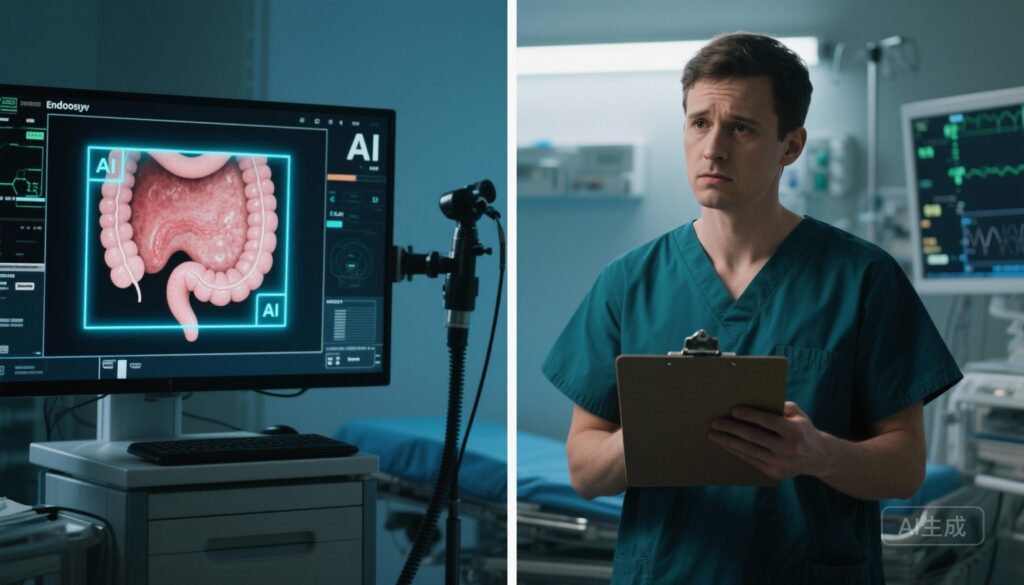Highlight
– Continuous exposure to AI-assisted polyp detection was associated with a statistically significant 6.0% absolute reduction in adenoma detection rate (ADR) for subsequent non‑AI standard colonoscopies (28.4% to 22.4%; p=0.0089) in a multicentre observational study (ACCEPT trial centres).
– In multivariable analysis, exposure to AI remained independently associated with lower ADR (OR 0.69), while older patient age and male sex predicted higher ADR.
– Findings raise the possibility of ‘deskilling’ or altered operator behaviour after routine AI use; implications include the need for monitoring, training adaptations, and AI design changes to mitigate reliance.
Background: Why ADR and Human Performance Matter
Adenoma detection rate (ADR) is a cornerstone quality metric for colonoscopy because higher ADRs are robustly associated with lower risks of interval colorectal cancer and colorectal cancer mortality. Landmark population data demonstrate that every 1% rise in ADR yields measurable reductions in post‑colonoscopy colorectal cancer risk. Therefore, interventions that alter ADR—positively or negatively—have direct implications for patient outcomes and screening program effectiveness.
Artificial intelligence (AI), particularly real‑time computer‑aided detection (CADe) systems, has been developed to assist endoscopists by flagging potential polyps during colonoscopy. Randomized and observational studies have generally reported improved ADR when AI is active, and AI is rapidly being implemented in endoscopy units worldwide. However, whether continuous exposure to AI changes endoscopist behaviour when AI is not available (for example, during system downtime or in units without AI) is not well characterised. The possibility of automation complacency, over‑reliance, or altered search strategies raises concern for inadvertent deskilling—where the user’s independent performance diminishes over time due to reliance on automated assistance.
Study Design
This retrospective, multicentre observational study used data from four Polish endoscopy centres participating in the ACCEPT trial. Centres introduced AI polyp‑detection tools at the end of 2021 and, per trial logistics, colonoscopies in the post‑implementation period were randomly assigned to AI or standard care according to the examination date. The investigators compared non‑AI standard colonoscopies performed during two time windows: 3 months before AI introduction (pre‑AI) and 3 months after AI introduction but when the procedure was performed without AI (post‑AI exposure). Inclusion criteria were diagnostic colonoscopies; exclusions included intensive anticoagulant use, pregnancy, prior colorectal resection, or inflammatory bowel disease.
The primary outcome was change in ADR for standard, non‑AI colonoscopies before versus after routine exposure to AI. Secondary analyses included multivariable logistic regression to identify independent predictors of ADR, and descriptive statistics of patient demographics and procedure mix.
Key Findings
Population and procedures
Between Sept 8, 2021, and March 9, 2022, the study evaluated 1,443 non‑AI colonoscopies: 795 performed before AI implementation and 648 performed after AI was available at the centres but not used for those procedures. Median patient age was 61 years (IQR 45–70); 58.7% were female.
Primary outcome: ADR change
The ADR for standard colonoscopy decreased from 28.4% (226/795) before AI implementation to 22.4% (145/648) after exposure to AI—an absolute difference of −6.0% (95% CI −10.5 to −1.6; p=0.0089). This finding indicates a statistically and clinically relevant decline in detection performance when endoscopists performed colonoscopy without AI after they had routinely worked with AI systems.
Multivariable predictors of ADR
After adjustment for potential confounders, exposure to AI remained independently associated with lower ADR (odds ratio [OR] 0.69; 95% CI 0.53–0.89). Other independent predictors associated with higher ADR were male patient sex (OR 1.78; 95% CI 1.38–2.30) and patient age ≥60 years compared with <60 years (OR 3.60; 95% CI 2.74–4.72). These demographic associations are consistent with known relationships between patient factors and polyp prevalence.
Interpretation of magnitude and clinical relevance
A 6% absolute reduction in ADR is meaningful: given the well‑established association between ADR and interval colorectal cancer, such a decline could translate into higher downstream cancer risk at the population level if sustained. The multivariable analysis strengthens the association by demonstrating that the decline is not explained solely by shifts in patient age or sex distribution. However, the study is observational and cannot prove causality; alternative explanations and biases remain possible (see limitations below).
Expert Commentary and Mechanistic Considerations
Why might ADR fall after AI exposure? Several non‑mutually exclusive mechanisms are plausible:
– Automation complacency/over‑reliance: Endoscopists accustomed to AI prompting may attenuate their visual search vigilance when the tool is absent, resulting in missed lesions.
– Altered search strategy: AI can change how operators scan the mucosa—focusing on AI prompts and potentially neglecting systematic mucosal inspection techniques that are necessary when AI is not available.
– Cognitive offloading: Endoscopists might rely on AI to detect fleeting or subtle findings and reduce their effortful detection processes.
– Selection and workflow factors: When AI is used in some cases but not others, workflow differences or scheduling (e.g., more complex cases assigned AI) could confound observed ADR changes.
These hypotheses align with human factors literature describing how automation can both augment and undermine operator skills depending on design, feedback, and task allocation.
Clinical and training implications
The study highlights a need for proactive strategies to preserve and monitor endoscopist skills as AI becomes integrated into practice. Possible measures include:
– Continuous monitoring of ADR at the operator level irrespective of AI use, with lower thresholds prompting retraining or review.
– Structured training curricula that explicitly teach polyp detection both with and without AI, emphasizing baseline visual search skills, withdrawal technique, insufflation, and mucosal exposure.
– Rotational or split‑practice models that ensure clinicians perform a minimum volume of non‑AI procedures to maintain unaided competency.
– Device and interface design changes such as AI modes that support learning (training mode), progressive reduction of prompt visibility, or dual feedback that encourages independent decision making.
– Simulation and competency assessment tools to objectively measure detection skill over time.
Limitations and Alternative Explanations
Important caveats temper the interpretation of these findings:
– Observational, non‑randomised design: Although pre/post comparisons with multivariable adjustment were used, residual confounding and temporal trends could account for some or all of the observed ADR decline.
– Case mix and scheduling biases: Even with exclusions, unmeasured differences in indications, bowel preparation quality, sedation, or lesion prevalence between periods might influence ADR.
– Hawthorne and performance biases: Knowledge of being observed or trial participation can change behaviour. Moreover, examination allocation to AI or non‑AI in the post‑implementation period (random by date) could create systematic differences.
– Short observation window: The analysis used three‑month pre and post windows. Longer follow‑up is needed to determine whether the decline is transient (e.g., during an adjustment period) or sustained.
– Generalisability: The study was conducted in four centres in Poland; results may differ in other healthcare systems, settings with different training models, or with other AI systems.
– Unmeasured operator factors: Individual endoscopist experience, baseline ADR, and attitudes toward AI were not detailed in the brief summary—these could modify effects.
Given these limitations, the data are hypothesis‑generating rather than definitive proof of causation.
Practical Recommendations for Clinicians and Units
– Monitor ADR continuously at the individual endoscopist level, stratified by AI use, and investigate unexpected declines promptly.
– Maintain competence through continuing education that includes non‑AI detection skill reinforcement—withdrawal technique, mucosal visualisation, and systematic inspection.
– When deploying AI, plan implementation science: define expected outcomes, collect baseline performance metrics, and incorporate steps to mitigate deskilling (e.g., dual‑mode training sessions).
– Engage human factors and ergonomics experts when integrating AI to design interfaces that support vigilance, reduce over‑reliance, and provide educational feedback.
– Report device downtimes and establish protocols for performing high‑quality non‑AI procedures when systems are unavailable.
Research and Policy Priorities
The study raises urgent questions for further research and regulation:
– Randomised trials or crossover designs are needed to isolate the causal effect of AI exposure on unaided performance and quantify duration and reversibility of any deskilling.
– Longitudinal studies following operators over longer intervals can clarify whether declines are transient or progressive and identify individual susceptibility factors.
– Investigation of AI design features (e.g., frequency and salience of prompts, training modes) that minimize negative behavioural effects.
– Policy guidance and device approval pathways should consider not only effectiveness with AI active but also the implications of routine AI use for unaided operator performance.
Conclusion
This multicentre observational study provides an important early signal that routine exposure to AI‑assisted polyp detection may be associated with reduced ADR when clinicians perform colonoscopy without AI. The finding is plausible from a human factors perspective and clinically meaningful given ADR’s link to cancer outcomes. However, observational design and potential confounding limit causal inference. Clinicians, device designers, and health systems should proactively monitor endoscopist performance, adapt training, and design AI systems to support—not supplant—core endoscopic skills. Further controlled and longitudinal research is required to confirm the phenomenon, elucidate mechanisms, and develop effective mitigation strategies.
Funding and Trial Information
The reported study was funded by the European Commission and the Japan Society for the Promotion of Science. The work used data from centres participating in the ACCEPT (Artificial Intelligence in Colonoscopy for Cancer Prevention) trial.
Selected References
1. Budzyń K, Romańczyk M, Kitala D, et al. Endoscopist deskilling risk after exposure to artificial intelligence in colonoscopy: a multicentre, observational study. Lancet Gastroenterol Hepatol. 2025 Oct;10(10):896-903. doi: 10.1016/S2468-1253(25)00133-5.
2. Corley DA, Jensen CD, Marks AR, et al. Adenoma detection rate and risk of colorectal cancer and death. N Engl J Med. 2014;370:1298–1306. PMID: 24881923.
(Additional literature on AI‑assisted colonoscopy and ADR is rapidly evolving; clinicians should consult recent systematic reviews and society guidance for the latest evidence and implementation recommendations.)



